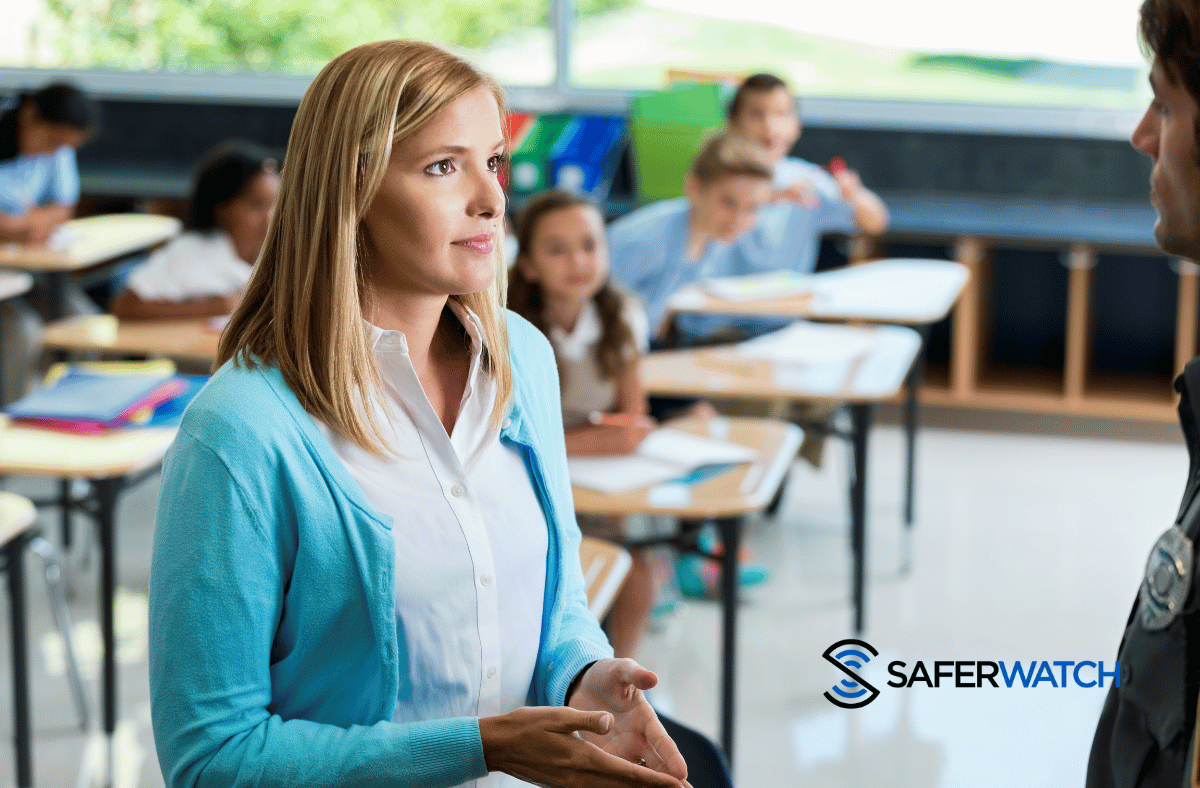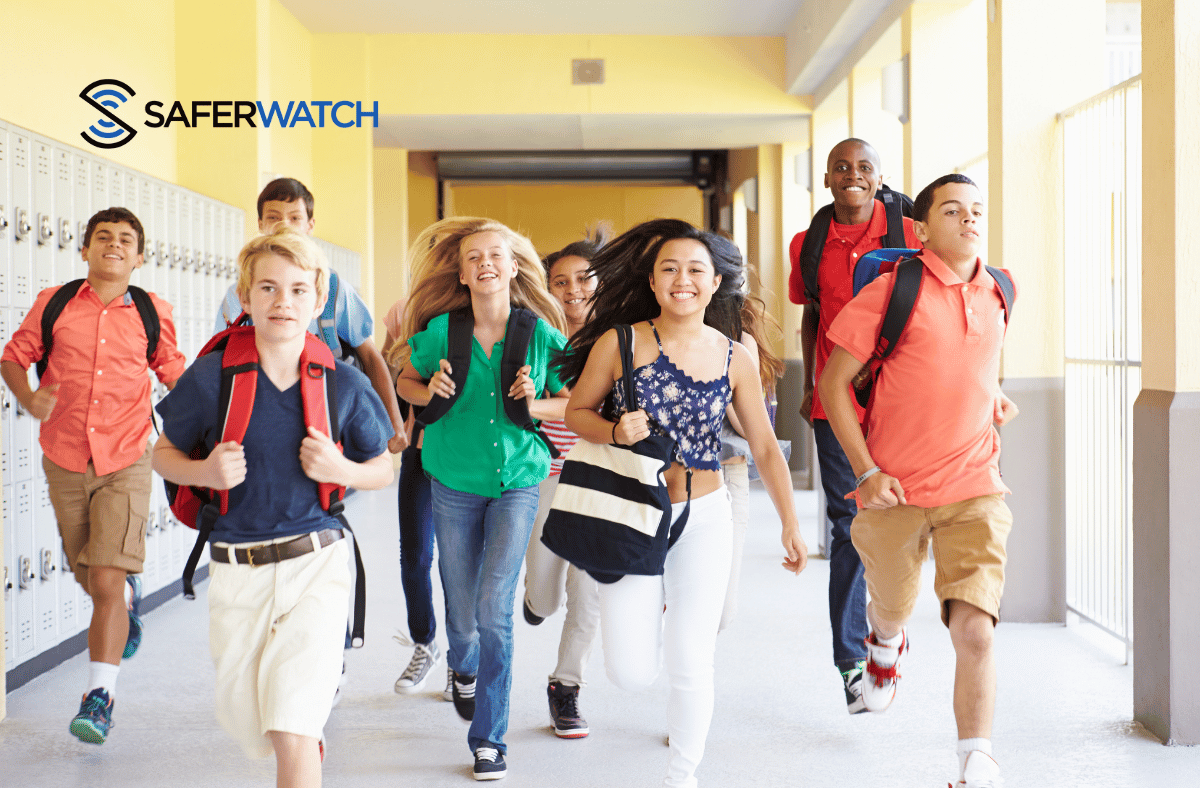Securing Our Schools: A Comprehensive School Safety Checklist for 2023

Securing Our Schools: A Comprehensive School Safety Checklist for 2023
School safety has never been more critical, and creating a safe learning environment is paramount. In this blog post, we’ll explore a comprehensive school safety checklist that covers risk assessment, emergency response procedures, communication strategies, and collaboration with local authorities.
A well-implemented emergency notification system for schools can increase enrollment as well as reassure parents and students alike so that all their focus can be on what really matters: learning and growing.
Additionally, Alyssa’s Law is passing in more states, which requires schools to install a silent panic alert in case of emergency situations. You can ensure you are meeting the requirements of Alyssa’s Law when you contact SaferWatch for a free demo: 844-449-2824.
Quick Summary
- Create a comprehensive school safety plan that assesses potential risks and threats, establishes emergency response procedures, develops communication strategies, and implements security measures.
- Collaborate with local authorities, mental health professionals, and community organizations to enhance school safety.
- Regularly review policies & procedures. Conduct drills & exercises, evaluate security measures, promote a positive climate & encourage student involvement.
Creating a Comprehensive School Safety Plan
A comprehensive school safety plan is the foundation of a secure learning environment. By collaborating with various organizations, including public safety officials and the national weather service, schools can stay informed about potential threats and allocate resources accordingly.
The key components of a school safety plan encompass threat assessment, the formation of a designated school safety team, the implementation of reporting systems, and the establishment of emergency action procedures.
Let’s dive deeper into these aspects.
Assessing Potential Risks and Threats
Identifying potential risks and threats is essential to create a secure learning environment. Schools face a myriad of challenges, including:
- Violence
- Theft
- Bullying
- Severe thunderstorms
By conducting threat assessments and staying informed about imminent threats, schools can prioritize safety measures and address vulnerabilities.
Establishing Emergency Response Procedures
In times of crisis, having well-established emergency response procedures can make all the difference. Schools must prepare for various scenarios, such as natural disasters, active shooter situations, medical emergencies, and amber alerts, to ensure they are ready to handle an actual emergency, including potential national emergency situations.
Collaborating with organizations like the Federal Emergency Management Agency (FEMA) can help schools access resources and expertise during emergencies.
Integrating a school emergency notification system with existing school systems and programs may facilitate keeping the system up-to-date and can be utilized in combination with other systems, such as security systems, to provide a comprehensive emergency response.
Developing Communication Strategies
Effective communication is crucial during emergencies. Schools need to develop strategies that ensure emergency alerts and emergency notifications reach their intended recipients swiftly. By employing multiple communication channels and collaborating with federal agencies, schools can guarantee to deliver important emergency information during critical situations.
Implementing a reliable emergency notification system in line with Federal Emergency Management Agency guidelines can significantly improve school safety.
Implementing Security Measures
To protect students and staff, schools must implement a variety of security measures. These can include physical security solutions, digital security measures, and training programs. Let’s explore these crucial aspects further.
Physical Security Solutions
Enhancing physical security involves implementing measures such as access control, surveillance cameras, and secure entry points. Working closely with public safety officials and local authorities can help schools develop robust physical security solutions that protect both people and property.
These measures can help to deter potential threats and provide a safe environment for students, faculty, and staff.
Digital Security Measures
In today’s technology-driven world, digital security is paramount. Schools must protect sensitive information and implement cybersecurity best practices, such as firewalls, encryption, and authentication.
Ensuring the security of wireless devices, including mobile device and mobile device usage, by students and staff is also essential when using a NOAA weather radio for receiving wireless emergency alerts.
Training and Awareness Programs
Training programs educate students and staff on safety protocols and emergency response, ensuring preparedness for various situations. By conducting drills, exercises, and awareness campaigns, schools can foster a culture of safety and equip their community with the knowledge and skills needed to face emergencies.
These activities can help create a safe and secure environment for students and staff, and can help to create a safe and secure environment for students and staff.
Collaborating with Local Authorities and Organizations
Strengthening school safety efforts requires collaboration with:
- Local authorities
- Law enforcement
- Mental health professionals
- Community organizations
These partnerships provide valuable resources and expertise that schools can leverage to enhance safety measures.
Schools can use these resources to develop comprehensive safety plans, implement safety protocols, and create a safety plan.
Working with Law Enforcement
Developing safety protocols and coordinating emergency response efforts with law enforcement can greatly enhance school safety. By working closely with local authorities, schools can access specialized resources and knowledge to address potential risks and emergencies.
Regularly reviewing and updating safety protocols with law enforcement ensures that schools remain prepared to address any possible threats or crises.
Partnering with Mental Health Professionals
Addressing student well-being is a critical aspect of school safety. By partnering with mental health professionals, schools can identify and resolve potential mental health issues among students and staff, and create a secure and supportive environment.
Mental health professionals can provide guidance on how to recognize signs of distress and how to respond to distress. Teachers can also take steps to monitor the mental health of students in their classrooms.
Engaging Community Organizations
Fostering relationships with community organizations can:
- Cultivate a sense of community
- Provide resources and support for students and staff
- Raise safety awareness
- Strengthen the school’s safety network.
By building relationships with local organizations, schools can create a sense of belonging and provide resources and support.
Regularly Reviewing and Updating School Safety Plans
Regularly reviewing and updating school safety plans ensures their effectiveness and adaptability to changing circumstances. This includes conducting drills and exercises, evaluating security measures, and updating policies and procedures.
Let’s examine these components in more detail.
Conducting Drills and Exercises
Testing emergency response procedures through drills and exercises helps identify areas for improvement and guarantees the efficacy of safety plans. Regular practice ensures preparedness and enables schools to address any gaps in their existing policies and procedures.
Drills and exercises can help identify any weaknesses in the emergency response plan and ensure that the plan is effective.
Evaluating Security Measures
Evaluating security measures is essential to ensure they remain effective and address emerging threats. Regular assessments, tests, and reviews should be conducted to identify areas for improvement and guarantee the speed and consistency of emergency notification systems, including the emergency alert system and the national public warning system.
These assessments should be conducted on a regular basis to ensure that the security measures are up to date.
Updating Policies and Procedures
Updating policies and procedures to reflect best practices and incorporate lessons learned from drills and real-life incidents is crucial to maintain a proactive and effective approach to school safety. Regular reviews and updates ensure that staff and students are prepared for any potential threats or crises.
Integrating School Safety into Everyday Operations
Integrating school safety into everyday operations is essential for a secure learning environment. This involves promoting a positive school climate, encouraging student involvement, and supporting staff training and professional development.
Let’s explore how these elements contribute to a safer school experience.
Promoting a Positive School Climate
Fostering a positive school climate involves addressing bullying, promoting inclusivity, and encouraging open communication. A supportive and inclusive environment helps students feel safe and respected, setting the stage for a secure learning experience.
Creating a positive school climate requires a commitment from all stakeholders, including students, parents, and teachers.
Encouraging Student Involvement
Empowering students to take an active role in maintaining a secure environment is vital for school safety. By providing them with resources and instruction, such as safety drills and emergency response protocols, students can contribute to the overall safety of the school.
Creating an environment where students feel safe and secure is essential for a successful learning environment. It is.
Supporting Staff Training and Professional Development
Investing in staff training and professional development ensures they possess the knowledge and skills necessary to effectively respond to emergencies and promote safety. Regular training and evaluations help staff stay informed of the latest safety regulations and processes, ultimately contributing to a secure learning environment.
By investing in staff training and professional development, organizations can ensure that their staff are equipped with the latest technology.
Full Summary
In conclusion, school safety is a multifaceted issue that requires a comprehensive approach. By developing a thorough safety plan, implementing security measures, collaborating with local authorities, regularly reviewing and updating safety plans, and integrating safety into everyday operations, schools can create a secure learning environment for students and staff alike. Remember, a safe school is a successful school.
SaferWatch technology and services are a crucial resource for children, caregivers, and educators. Contact SaferWatch to learn more about advanced mobile panic alarm solutions and other tools that prevent crises and ensure safety in educational facilities. Call today to schedule a free demo: 844-449-2824.
Remember that in some cases, there are government grants for school safety that can subsidize an emergency alert system like SaferWatch.
Frequently Asked Questions
What is a daily safety checklist?
A daily safety inspection checklist is a tool that allows you to evaluate key workplace health and safety issues that could arise on a daily basis. It helps to monitor the work conditions, incidents, and safety compliance of people, processes, and machinery.
By using a daily safety inspection checklist, you can identify potential hazards and take steps to prevent them from occurring. This can help reduce the risk of accidents and injuries in the workplace, as well as improve overall safety.
What is the indoor safety rule?
Keep sharp items out of children’s reach, and take caution with objects that may become choking or strangulation hazards.
Ensure any chains and cords are shorter than 5 cm or wrapped around cleats at least 1.6 m above the floor.
What is a playground safety checklist?
A playground safety checklist includes inspecting equipment for cracks, warps, rusting or breakage of any component, checking for tripping hazards such as exposed footings and roots, checking wooden slides for splintering wood, and looking for slipping hazards like sand on walkways.
Inspecting equipment should include looking for any cracks, warps, rusting, or breakage of any component. It is also important to check for tripping hazards such as exposed footings and roots. Wooden slides should be checked for splintering wood, and slipping hazards such as sand on walkways should be looked for.
What are the key components of a school safety plan?
A school safety plan should include threat assessment, a dedicated safety team, reporting systems, emergency procedures, and collaboration with first responders to ensure the safety of students and faculty.
Threat assessment is an important part of any school safety plan. It involves identifying potential threats and assessing the risk of those threats. A dedicated safety team should be established to monitor and respond to any potential threats. Reporting systems should be in place to ensure that reporting systems are in place.
How can schools prioritize safety measures?
Schools can prioritize safety by assessing potential risks and threats, considering severity, likelihood, and potential impact.
They can also create emergency plans and protocols to ensure that staff and students are prepared in the event of an emergency.
Regular drills and training can help staff and students become familiar with the system.
SaferWatch In the News:
- Motorola Solutions and SaferWatch Align to Support School Safety
- App Developed for Educators In Case of A School Shooting
- BCPS Unveils Alyssa’s Alert In New Initiative To Add Additional Layer of Security for Students and Staff
- Stand With Parkland Partners With SaferWatch Mobile App to Protect Schools
- Alyssa’s Law Reviewed by MSD Commission
- BCPS uses SaferWatch app to comply with Alyssa’s Law
- BSO: 12-Year-Old Boy Arrested For Making School Shooting Threat
- Fort Lauderdale Police Investigate Three School Threats




























